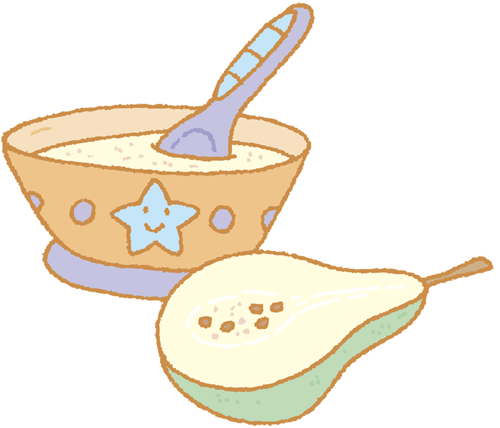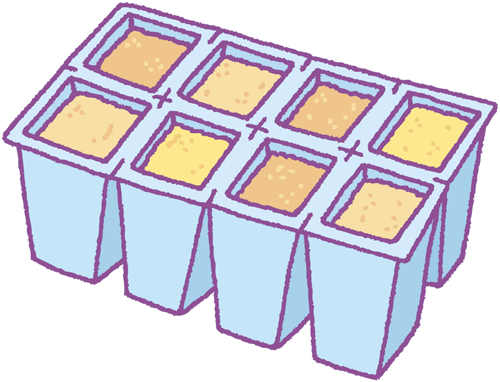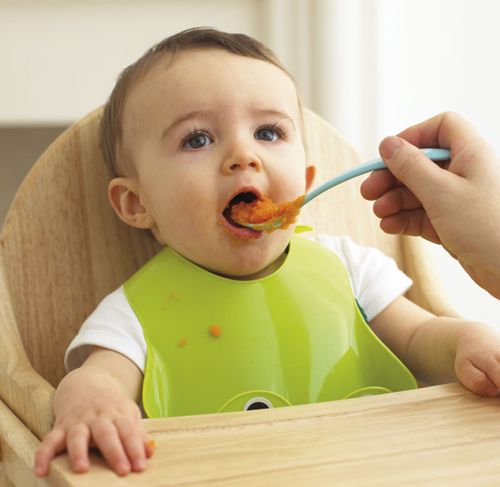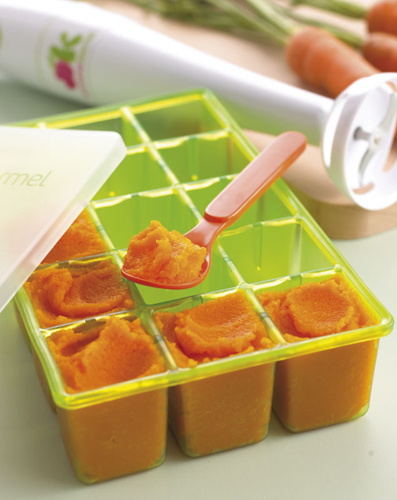|
This time is an important transition for you and your baby. Whether she’s a slow starter or instant foodie, you’ll both take pleasure in the process of mastering self-feeding, introducing new tastes, and enjoying the world of food.

| Q: |
Can I wait longer than six months to introduce first foods?
| | A: |
It may be tempting to wait, given that your baby’s digestive and
immune systems will be that much more mature, but it doesn’t help to do
so.
For one thing, babies
who start later often find it difficult to manage lumps, and may be
more reluctant to try new tastes and textures. Also, if you wait to
introduce fruits and vegetables, you’ll delay moving on to protein-rich
foods, such as oily fish, which contain essential fatty acids that are
vital for your baby’s development. Also, a baby’s iron supply, inherited
from his mother, runs out at six months, so it’s important not to wait
too long before introducing iron-rich foods such as red meat and
lentils. With regards to food allergies, there is no evidence that
delaying the introduction of allergenic foods (such as cow’s milk, egg,
wheat, fish, and soy) after the six-month mark makes your child less
likely to have food allergies.
|
| Q: |
What is the best way to introduce solids to my baby?
| | A: |
Firstly, don’t worry about how much your baby is eating. The idea
of first foods is to encourage your baby to experience new tastes and
textures, and to get used to the idea of taking something from a spoon
and swallowing it. While nutrition is important—meaning, simply, that
everything you offer your baby should be fresh and nutritious—it’s
actually more important that she develops a taste for a variety of
different foods.
It’s perfectly fine to introduce new foods to your baby each day. If there is a history of allergy in the family ,
you may like to offer a new food every two or three days, so you can
watch out for any signs of a reaction. Reactions that can indicate a
potential problem include skin rashes, vomiting, diarrhea, and even
breathing difficulties.
To begin with,
offer food halfway through a milk feed, so your baby isn’t frantically
hungry. At first, the purées need to be semi-liquid, and as much like
milk in consistency as possible so that they are easy to swallow—add
breast milk, formula, or a little water from the bottom of the steamer
or saucepan, to thin the purée.
|
| Q: |
What is “baby-led” weaning?
| | A: |
Baby-led weaning is an interesting concept. The idea is that you
skip the purée stage, and allow your baby to feed herself. It is
believed that babies who are weaned in this way are less likely to
become fussy eaters, but there is no evidence to support this.
Many feeding
difficulties can start when babies make the transition from purées to
lumpier foods, to which they are often resistant. Instead, babies are
encouraged to chew from the outset, eating what they want from a
selection of foods that can be picked up and held . Your baby may play with or suck the food, but eventually she’ll eat more and develop healthy eating habits.
There is, of course, a
risk of choking, as babies may bite off a chunk of food that they are
then unable to chew and swallow, so you should never leave your baby
unattended. Your baby may also choose to eat the same few foods,
avoiding foods that don’t appeal, unlike when you choose your baby’s
purées and you’re in the driving seat.
Ultimately it’s up to
you. Personally, I like the idea of introducing different tastes and
textures in the form of purées, which babies can easily master and
digest. You can then make a gradual transition to lumpier foods and
finger foods, over a few weeks.
|
| Q: |
What is the best first weaning food?
| | A: |
Root vegetables are a good first bet, so consider potatoes, carrots, sweet potatoes, and parsnips.
Baby rice is also a
good start, but I prefer to mix it with fruit or vegetable purées, as it
is very bland on its own. At first, mix it with very runny purées, such
as pear.
Mashed avocados
are sweet and extremely nutritious, and as your baby becomes accustomed
to different vegetables, you can start to introduce fruit. Sometimes
it’s a good idea to blend fruit with vegetables at the outset, as clever
babies will work out that fruit is sweeter, and reject their favorite
vegetable purées in favor of fruit. Always start a meal with a vegetable
purée, or fruit and vegetable blend, and then move on to fruit, so that
your baby gets a good balance of vitamins and minerals, and doesn’t
turn her nose up at the veggies once she’s had a taste of the sweeter
fruit.
|
| Q: |
Is it a good idea to put baby rice or other cereals in my baby’s bottle?
| | A: |
This is a long out-dated practice, and it should not be
undertaken. When your baby is ready for solids, these should be offered
with a spoon (or as a finger food) and not via a bottle. One of the
important elements of weaning is teaching your little one to remove food
from a spoon, to chew or “gum” it, and then to swallow. If you offer
these first foods in a bottle, your baby will not learn these skills,
which are a key part of her developmental process.
Parents may be tempted
to offer a little “extra” in their baby’s bottle, in the hope that they
will get a little more sleep by keeping tummies full; however, food in
the bottle can pose a choking hazard.
While it’s OK to offer
cereal as a first taste, it’s better to introduce a variety of
nutritious fresh purées as your baby grows. Babies tend to eat pretty
well in the first year, so it’s a great opportunity to offer as much
variety as possible.
|
| Q: |
Do I need special equipment for making purées?
| | A: |
You don’t need much more than a food processor and ice cube tray,
but there are a few things that might make life a little easier.
It’s worth buying
a multi-layered steamer, because steaming or microwaving is the best
way to preserve the nutrients in vegetables, and a multi-layered steamer
allows you to cook several vegetables at one time. If you use a
microwave, a dish with a valve in the lid that opens to release steam is
ideal for cooking fish or vegetables. A baby food grinder, which is a
hand-turned food mill, can be very useful, especially in the early weeks
when you’ll be making very smooth purées. It is great for foods with
tough skins, such as peas or dried apricots, since it discards the bits
that are indigestible. It’s also good for potatoes, as puréeing potato
in a food processor tends to break down the starches and produces a
sticky, glutinous pulp.
Another useful addition is
an electric hand blender. This is ideal for making baby purées, as it
can handle very small quantities.
Store purées in an ice
cube tray with a lid, if possible, to keep food covered for maximum
freshness. One that is flexible, too, makes decanting the frozen purées
that much easier. As your baby gets older, it’s a good idea to purchase
some mini pots with lids, to freeze larger quantities of food.
A mini-masher and bowl
can be useful too, since it’s ideal for mashing small quantities like
one banana or a mix of potato, broccoli, and cheese, for example, and
you can feed your baby from the same bowl.
Finally, look out for a mini-thermos so that you can take warm, homemade purées with you when you are out and about.
|
| Q: |
I don’t know how I’ll have time to make purées every day. Do you have any advice?
| | A: |
Since a baby eats only tiny amounts, especially in the early
stages of weaning, it saves time to make baby food in batches and freeze
extra portions in ice cube trays for future meals. If you cook for a
few hours on the weekend, you could make all your baby’s food for a
week.
|

| Q: |
What is the best way to cook my baby’s vegetables?
| | A: |
Steaming vegetables is a great way to preserve their fresh taste
and nutrients. Vitamins B and C are water soluble and are destroyed by
cooking, especially when boiled in water. Broccoli, for example, loses
over 60 percent of its antioxidants when boiled, but less than 7 percent
when steamed.
Microwaving is also a
good way of cooking vegetables. It requires very little water and the
soluble vitamins B and C aren’t leached out into the water (as they are
when boiled). It’s a very quick way of cooking too—and is an ideal way
to cook fish, which takes just a few minutes. Don’t be put off by
microwaving—it is a safe way to cook as long as you follow the
manufacturer’s instructions.
|
| Q: |
At what temperature should I serve my baby’s food?
| | A: |
Your baby’s food should be given at body temperature ,
as babies’ palates are very sensitive. If reheating food in a
microwave, heat until piping hot, allow to cool, then stir thoroughly to
get rid of any hot spots and check the temperature before giving it to
your baby.
|
| Q: |
Are frozen purées as nutritious as fresh?
| | A: |
If you freeze your purées as soon as they are cool, and cover
them with a lid, they are as nutritious as fresh, and will remain so for
about eight weeks in the freezer (see Storing purées).
Leaving a purée
sitting around in the fridge means that its nutritional content will be
slowly compromised, and freezing it at this stage will certainly not
make it more nutritious.
Freezing does
effectively preserve nutrients, so if you know that you won’t be using
all of the purée you have just made, it’s a good idea to freeze it as
soon as it has cooled and use it when it’s needed, at which point it
will be perfectly fresh and nutritious. Label the food with the contents
and expiration date.
Thaw foods by
defrosting them in the fridge overnight, or by taking them out of the
freezer several hours before a meal. Sometimes you may need to add a
little liquid when reheating frozen food, because freezing can cause it
to dry out.
|
Did you know…
that the more tastes to
which you introduce your young baby, and the wider the range of
combinations, the more likely he is to develop his “palate” and enjoy
different foods? Try introducing new foods one at a time at the outset,
and then, when the food has been successfully introduced, offer a blend.
When introducing stronger-tasting flavors, like spinach or broccoli, it
is a good idea to mix them with a root vegetable, such as a sweet
potato or carrot.

Storing purées
Fresh purées will last 48
hours in the fridge and eight weeks in the freezer. The temperature of
your fridge should be 40°F (4°C) and your freezer 0°F (-18°C). You
shouldn’t reheat food more than once and never refreeze foods. It’s OK,
however, to refreeze vegetables, such as frozen peas.
Carrot Purée
Root vegetables make the perfect first weaning food because of their naturally sweet taste and smooth texture when puréed. Orange-colored root vegetables are rich in beta-carotene, which is essential for growth, healthy skin, good vision, and strong bones. The recipe will also work for sweet potato, parsnip, or rutabaga.

2 minutes
About 15 minutes
Put the carrots in a
steamer set over boiling water and cook until really tender, 15–20
minutes (the smaller the pieces, the quicker they will cook).
Alternatively, place the carrots in a saucepan and just cover with
boiling water. Bring back to a boil, then reduce the heat and simmer
until very tender, about 15 minutes; drain, reserving the cooking
liquid.
Purée the carrots
until very smooth, adding some of the cooking liquid or some of the
water in the bottom of the steamer. The amount of liquid you add really
depends on your baby—you may need to add more if your baby finds it hard
to swallow.
Let cool, then serve
one portion and freeze the remainder in ice cube trays or small pots.
If frozen, thaw overnight in the refrigerator, then reheat in the
microwave or a small pan until piping hot. Stir and let cool before
serving.
|